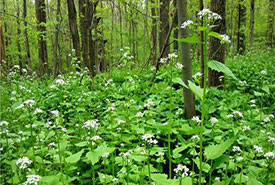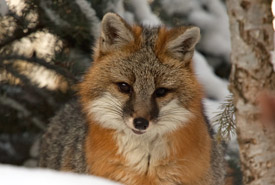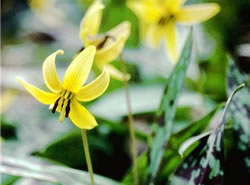Getting rid of the garlic

Invasive garlic mustard can take over forests, harming native understory species (Photo by NCC)
Garlic mustard might sound tasty, and it is, but it’s also an alien invader that the Nature Conservancy of Canada (NCC) is battling on Pelee Island in southwestern Ontario.
Pelee Island is home to the elusive gray fox. NCC is working here to make sure that this important and rare animal has a place to roam, eat, mate and thrive. That’s one of the reasons we’re taking on the challenge of getting rid of the garlic.
NCC staff spent many days in the spring of 2018 getting rid of garlic mustard on all five of the places we work on Pelee Island. It’s hard work ― all that bending and pulling this smelly weed ― but someone has to do it!
Garlic mustard was brought to North America by early settlers from Europe as an herb for cooking. Unfortunately, the plant escaped into the wild. Because it has no native predators, it began to spread like wildfire and take over forest floors throughout Canada. When plants and animals that originate from other countries do this, we call them invasive.

Gray fox (Photo by John James Henderson)
Taking out invasive species like garlic mustard is very important for forests and the species that live in them. These plants can push out native wildflowers and trees, which means there is less food and habitat for insects. This creates a chain reaction all through the food web; all the way up to mammals, like gray foxes.
Battling garlic mustard is not a very exciting task. NCC staff spend long days sitting or bending to pull out hundreds of plants, filling buckets and then dumping them in a pile. Sometimes garlic mustard seeds can continue to grow deep in the soil even after the plant is pulled, so getting as much as possible before they release their seeds is important.

Yellow trout-lily (Photo by Jean Isaacs)
In the woods where we’ve been pulling for several years, garlic mustard is nearly gone. Wildflowers, like Dutchman’s breeches and trout lily, are flourishing. And it’s not all hard labour — it’s always nice to spend a day outside in the forest. Because we do this work in the early spring, we are able to see and hear many of the migrating spring birds, such as the brightly coloured warblers that stop for a moment to refuel before continuing their long trip north.
While we didn’t spot any secretive gray foxes this year, a pair of red foxes made a den right outside the house where we were living. Baby red foxes (called kits) are very curious and followed us around from a distance, trying to work out who we were and what we were doing.
Thanks to Earth Rangers, we were able to spend time getting rid of invasive plants like garlic mustard from large areas of rocky forest and plant a former farm field with native wildflowers last fall. While the field might look messy now, it will grow into a beautiful meadow over the next few years. This will provide homes for many insects, birds and small mammals, and hunting grounds for gray fox. We were excited to find an endangered eastern foxsnake in one of these newly planted areas this spring; evidence that, if you build it, they will come!

